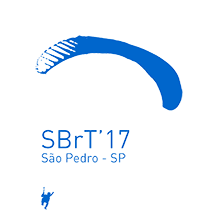
XXXV Simpósio Brasileiro de Telecomunicações e Processamento de Sinais
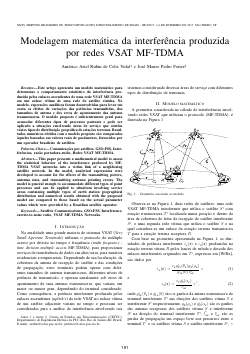
Modelagem matemética da interferência produzida por redes VSAT MF-TDMA
Americo Ariel Rubin de Celis Vidal, Jose Mauro Pedro Fortes
DOI: 10.14209/sbrt.2017.219
Keywords: Satellite Communications GSO-FSS Interference carrier-to-noise ratio VSAT MF-TDMA Networks
Abstract
This paper presents a mathematical model to assess the statistical behavior of the interference produced by MF- TDMA VSAT networks into a victim link of a neighboring satellite network. In the model, analytical expressions were developed to account for the effects of the transmitting powers, antenna sizes, and transmitting antenna pointing errors. The model is general enough to accommodate different types of point processes and can be applied to situations involving service areas containing multiple types of earth station geographical distribution and numerical results obtained with the proposed model are compared to those based on the actual parameter values which were provided by a Brazilian satellite operator.Download

PDI para o Monitoramento de Rodovias com Imagens Aéreas Obtidas por VANT
André Biffe Di Renzo, Cicero Martelli, Rogério Vargas Cezimbra, Jean Carlos Cardozo da Silva
DOI: 10.14209/sbrt.2017.220
Keywords: Unmanned Aerial Vehicle Road Monitoring Image processing
Abstract
Aerial images can provide important information for highway management. This paper presents the use of an Unmanned Aerial Vehicle (UAV) in remote sensing of highways, acquiring aerial images, and algorithms that process the images and extract specific parameters. The highway monitoring through aerial images provides a large scan area with reduced time. Through these images it is possible to analyze the traffic information, signalizing, imperfections in the highway and infrastructure management. The presented results demonstrate the viability in applying the image processing algorithms to extract and recognize points of interest on a highway.Download

Modeling and Simulation of Underwater Acoustic Communication Systems
Rafael S. Chaves, Wallace A. Martins, Paulo S. R. Diniz
DOI: 10.14209/sbrt.2017.218
Keywords: OFDM Underwater Acoustic Channel Doppler Effect
Abstract
This work describes a simple model for underwater acoustic (UWA) channels, taking into account Doppler effects. The performance of orthogonal frequency-division multiplexing (OFDM) systems in UWA channels is also studied. The impact of Doppler effects on OFDM transmissions is thoroughly investi- gated, and a simple two-step compensation strategy is described. In order to evaluate UWA models, a versatile UWA channel simulator is developed and some simulations are performed to measure the OFDM performance for time-variant channels. Those simulations evaluate the bit-error-rate and sensitivity of OFDM systems to Doppler effects. The results are satisfactory and show that only one compensation step is necessary to maintain a reasonable system performance for relative estimation errors of Doppler scaling factor in the order of 10−5, corroborating that OFDM systems are suitable in some specific scenarios.Download
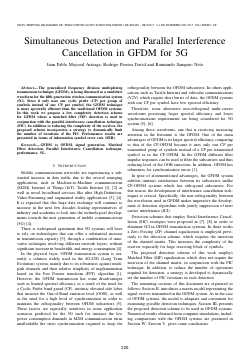
Simultaneous Detection and Parallel Interference Cancellation in GFDM for 5G
Juan Pablo Mayoral Arteaga, Rodrigo Pereira David, Raimundo Sampaio Neto
DOI: 10.14209/sbrt.2017.221
Keywords: GFDM vs OFDM signal generation Matched Filter detection Parallel Interference Cancellation technique performance 5G
Abstract
The generalized frequency division multiplexing transmission technique (GFDM), is being discussed as a candidate waveform for the fifth generation wireless communication system (5G). Since it only uses one cyclic prefix (CP) per group of symbols instead of one CP per symbol, the GFDM technique is more spectrally efficient than the traditional OFDM systems. In this work we propose a low complexity detection scheme for GFDM where a matched filter (MF) detection is used in conjunction with the parallel interference cancellation technique (PIC). In addition to reducing the complexity of the receiver, the proposed scheme incorporates a strategy to dynamically limit the number of iterations of the PIC. Performance results are presented in terms of information symbol error rate (SER).Download
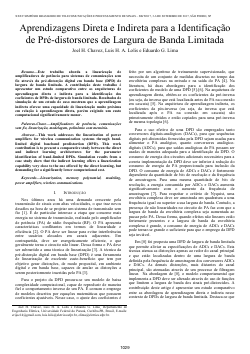
Aprendizagens Direta e Indireta para a Identificação de Pré-distorsores de Largura de Banda Limitada
Joel H. Chavez, Luis H. A. Lolis, Eduardo G. Lima
DOI: 10.14209/sbrt.2017.222
Keywords: Linearization memory polynomial modeling power amplifiers wireless communications
Abstract
This work addresses the linearization of power amplifiers for wireless communication systems through band- limited digital baseband predistortion (DPD). This work contribution is to present a comparative study between the direct and indirect learning architectures for the parameter identification of band-limited DPDs. Simulation results from a case study show that the indirect learning offers a linearization capability very close to the one offered by the direct learning, but demanding for a significantly lower computational cost.Download
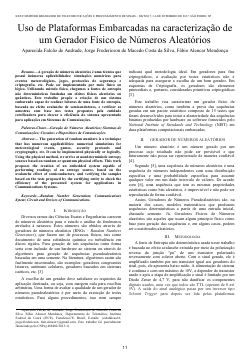
Uso de Plataformas Embarcadas na caracterização de um Gerador Físico de Números Aleatórios
Aparecida Falcão de Andrade, Jorge Fredericson de Macedo Costa da Silva, Fábio Alencar Mendonça
DOI: 10.14209/sbrt.2017.224
Keywords: Random Number Generation Communications Sytem Circuit and Devices of Communications
Abstract
The generation of random numbers is a technique that has numerous applicabilities: numerical simulations for meteorological events, games, security protocols and cryptography, etc. It can be implemented physically or logically. Using the physical method, we arrive at nondeterministic entropy sources based on random or quantum physical effects. This work proposes the creation of an embedded system capable of performing readings of an entropy source, based on the avalanche effect of semiconductors, and verifying the samples based on the tests proposed by the certifying entity to check the efficiency of the presented system for applications in Communications Systems.Download
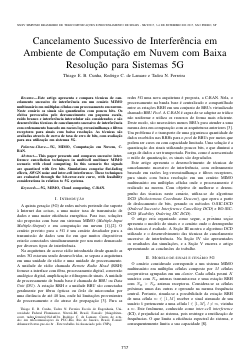
Cancelamento Sucessivo de Interferencia em Ambiente de Computação em Nuvem com Baixa Resolução para Sistemas 5G
Thiago E. B. Cunha, Rodrigo C. de Lamare, Tadeu N. Ferreira
DOI: 10.14209/sbrt.2017.225
Keywords: 5G MIMO Cloud computing C-RAN.
Abstract
This paper presents and compares sucessive inter- ference cancellation techniques in multicell multiuser MIMO scenario with cloud computing. In this scenario the signals are quantized with few bits. Simulations comprise flat-fading effects, AWGN noise and inter-cell interference. These techniques are evaluated through the bit-error-rate curve, with feasibility considerations in relation to 5G systems.Download

Análise de Parâmetros para Desagregação de Sinais de Consumo de Energia Elétrica
Pierre V. Dantas, Kenny V. dos Santos, Luiz E. S. e Silva, Celso B. Carvalho, Waldir S. S. Júnior
DOI: 10.14209/sbrt.2017.226
Keywords: disaggregation dictionaries parameter analysis
Abstract
In this article, we address the problem of energy disaggregation that can be handled through dictionaries techni- ques where we synthesize the most representative characteristics of the signals involved to carry out the disaggregation. In our proposal, we can highlight two contributions. In the first one, we modified the steady-state identification algorithm to handle signals of different dimensions and then performed an analysis of parameters that influence the formation of the dictionaries and, consequently, produce different disaggregation performances. The experiments were carried out using the Reference Energy Disaggregation Data Set (REDD) database. The results show that the proposal produces good disaggregation performance.Download
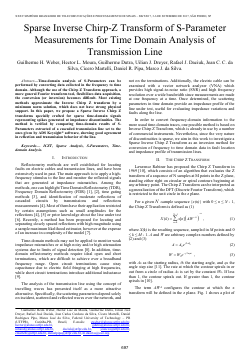
Sparse Inverse Chirp-Z Transform of S-Parameter Measurements for Time Domain Analysis of Transmission Line
Guilherme H. Weber, Hector L. Moura, Guilherme Dutra, Uilian J. Dreyer, Rafael J. Daciuk, Jean C. C. da Silva, Cicero Martelli, Daniel R. Pipa, Marco J. da Silva
DOI: 10.14209/sbrt.2017.227
Keywords: ICZT Sparse Analysis S-Parameters Time- domain Analysis
Abstract
Time-domain analysis of S-Parameters can be performed by converting data collected in the frequency to time domain. Although the use of the Chirp Z Transform approach, a more general Fourier transform tool, flexibilizes data acquisition, the conversion (or inversion) becomes difficult. Most existing methods approximate the Inverse Chirp Z transform by a minimum norm solution, which does not have strong physical support. In this paper, we propose a Sparse Inverse Chirp Z transforms specially crafted for sparse time-domain signals representing spikes generated at impedance discontinuities. The method is verified by comparing time-domain results of S- Parameters extracted of a cascaded transmission line set to the ones given by ADS Keysight® software, showing good agreement in reflection and transmission behavior of the line.Download
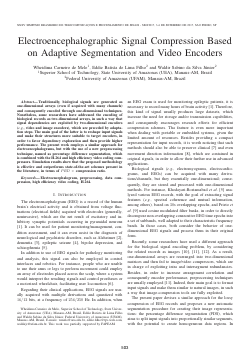
Electroencephalographic Signal Compression Based on Adaptive Segmentation and Video Encoders
Wheidima Carneiro de Melo, Eddie Batista de Lima Filho, Waldir Sabino da Silva Junior
DOI: 10.14209/sbrt.2017.228
Keywords: Electroencephalogram preprocessing data com- pression high efficiency video coding H.264
Abstract
Traditionally, biological signals are generated as one-dimensional arrays (even if acquired with many channels) and consequently encoded through one-dimensional techniques. Nonetheless, some researchers have addressed the encoding of biological records as two-dimensional arrays, in such a way that signal dependencies are exploited by two-dimensional encoders (e.g., video and image encoders), which are preceded by adapta- tion steps. The main goal of the latter is to reshape input signals and make their structures more suitable to target encoders, in order to favor dependency exploration and then provide higher performance. The present work employs a similar approach for electroencephalograms, but with the use of a new preprocessing technique, named as percentage difference segmentation, which is combined with the H.264 and high efficiency video coding com- pressors. Simulation results show that the proposed methodology is effective and outperforms state-of-the-art schemes present in the literature, in terms of P RD × compression ratio.Download